静电放电(ESD)理论研究的已经相当成熟,为了模拟分析静电事件,前人设计了很多静电放电模型。
常见的静电模型有:人体模型(HBM),带电器件模型,场感应模型,场增强模型,机器模型和电容耦合模型等。芯片级一般用HBM做测试,而电子产品则用IEC 6 1000-4-2的放电模型做测试。为对 ESD 的测试进行统一规范,在工业标准方面,欧共体的 IEC 61000-4-2 已建立起严格的瞬变冲击抑制标准;电子产品必须符合这一标准之后方能销往欧共体的各个成员国。因此,大多数生产厂家都把 IEC 61000-4-2看作是 ESD 测试的事实标准。我国的国家标准(GB/T 17626.2-1998)等同于I EC 6 1000-4-2。大多是实验室用的静电发生器就是按 IEC 6 1000-4-2的标准,分为接触放电和空气放电。静电发生器的模型如图 1。 放电头按接触放电和空气放电分尖头和圆头两种。


IEC 61000-4-2的 静电放电的波形如图2,可以看到静电放电主要电流是一个上升沿在1nS左右的一个上升沿,要消除这个上升沿要求ESD保护器件响应时间要小于这个时间。静电放电的能量主要集中在几十MHz到500MHz,很多时候我们能从频谱上考虑,如滤波器滤除相应频带的能量来实现静电防护。其放电频谱如下,这个图是我自己画的,只能定性的看,不能定量。

IEC 61000-4-2规定了几个试验等级,目前手机CTA测试执行得是3级,即接触放电6KV,空气放电8KV。很多手机厂家内部执行更高的静电防护等级。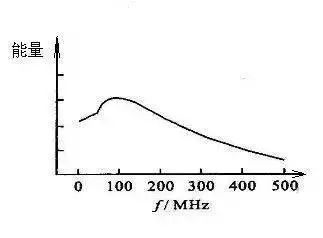
当集成电路( IC )经受静电放电( ESD)时,放电回路的电阻通常都很小,无法限制放电电流。例如将带静电的电缆插到电路接口上时,放电回路的电阻几乎为零,造成高达数十安培的瞬间放电尖峰电流,流入相应的 IC 管脚。瞬间大电流会严重损伤 IC ,局部发热的热量甚至会融化硅片管芯。ESD 对 IC的损伤还包括内部金属连接被烧断,钝化层受到破坏,晶体管单元被烧坏。
ESD 还会引起 IC 的死锁( LATCHUP)。这种效应和 CMOS 器件内部的类似可控硅的结构单元被激活有关。高电压可激活这些结构,形成大电流信道,一般是从 VCC 到地。串行接口器件的死锁电流可高达 1A 。死锁电流会一直保持,直到器件被断电。不过到那时, IC 通常早已因过热而烧毁了。
电路级ESD防护方法.
1、并联放电器件
常用的放电器件有TVS,齐纳二极管,压敏电阻,气体放电管等。如图

1.1、齐纳二极管( Zener Diodes ,也称稳压二极管 ) : 利用齐纳二极管的反向击穿特性可以保护 ESD敏感器件。但是齐纳二极管通常有几十 pF 的电容,这对于高速信号(例如 500MHz)而言,会引起信号畸变。齐纳二极管对电源上的浪涌也有很好的吸收作用。
1.2、瞬变电压消除器 TVS(Transient Voltage Suppressor):TVS 是一种固态二极管,专门用于防止 ESD 瞬态电压破坏敏感的半导体器件。与传统的齐纳二极管相比, TVS 二极管 P/N 结面积更大,这一结构上的改进使 TVS 具有更强的高压承受能力,同时也降低了电压截止率,因而对于保护手持设备低工作电压回路的安全具有更好效果。
TVS二极管的瞬态功率和瞬态电流性能与结的面积成正比。该二极管的结具有较大的截面积,可以处理闪电和 ESD所引起的高瞬态电流。TVS也会有结电容,通常0.3个pF到几十个pF。TVS有单极性的和双极性的,使用时要注意。手机上用的TVS大约0.01$,低容值的约2-3分$。
1.3、多层金属氧化物结构器件 (MLV):大陆一般称为压敏电阻。MLV也可以进行有效的瞬时高压冲击抑制,此类器件具有非线性电压 - 电流 ( 阻抗表现 ) 关系,截止电压可达最初中止电压的 2 ~ 3倍。这种特性适合用于对电压不太敏感的线路和器件的静电或浪涌保护,如电源回路,按键输入端等。手机用压敏电阻约0.0015$,大约是TVS价格的1/6,但是防护效果没有TVS好,且压敏电阻有寿命老化。
2、串联阻抗
一般可以通过串联电阻或者磁珠来限制ESD放电电流,达到防静电的目的。如图。如手机的高输入阻抗的端口可以串1K欧电阻来防护,如ADC,输入的GPIO,按键等。不要担心0402的电阻会被打坏,实践证明是打不坏的。这里不详细分析。用电阻做ESD防护几乎不增加成本。如果用磁珠,磁珠的价格大 约0.002$,和压敏电阻差不多。
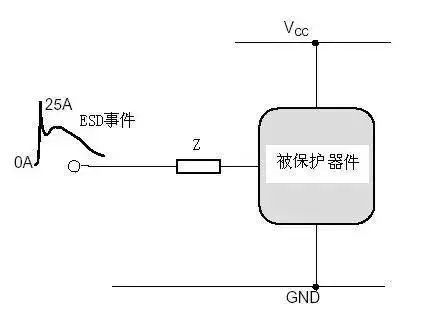
3、增加滤波网络
前面提到了静电的能量频谱,如果用滤波器滤掉主要的能量也能达到静电防护的目的。
对于低频信号,如GPIO输入,ADC,音频输入可以用1k+1000PF的电容来做静电防护,成本可以忽略,性能不比压敏电阻差,如果用1K+50PF的压敏电阻(下面讲的复合防护措施),效果更好,经验证明这样防护效果有时超过TVS。

对于射频天线的微波信号,如果用TVS管,压敏等容性器件来做静电防护,射频信号会被衰减,因此要求TVS的电容很低,这样增加ESD措施的成本。对于微波信号可以对地并联一个几十nH的电感来为静电提供一个放电通道,对微波信号几乎没有影响,对于900MHZ和1800MHz的手机经常用22nH的电感。这样能把静电主要能量频谱上的能量吸收掉很多。
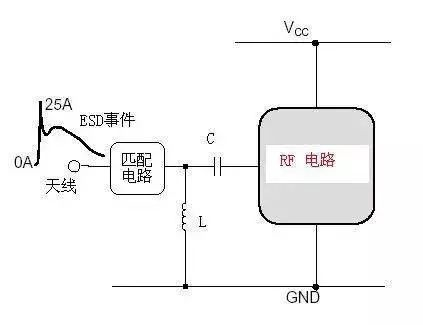
4、复合防护
有一种器件叫EMI filter,他有很好的ESD防护效果,如图。EMI filter也有基于TVS管的和基于压敏电阻的,前者效果好,但很贵,后者廉价,一般4路基于压敏电阻的EMI价格在0.02$。
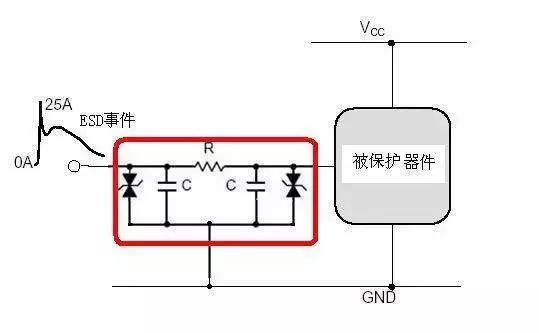
实际应用中可以用下面的一个电阻+一个压敏电阻的方式。他既有低通滤波器的功能,又有压敏电阻的功能,还有电阻串联限流的功能。是性价比最好的防护方式,对于高阻信号可以采用1K电阻+50PF压敏;对于耳机等音频输出信号可以采用100欧电阻+压敏电阻;对于TP信号串联电阻不能太大否则影响TP的线性,可以采用10欧电阻。虽然电阻小了,低通滤波器效果已经没有了,但限流作用还是很重要的。
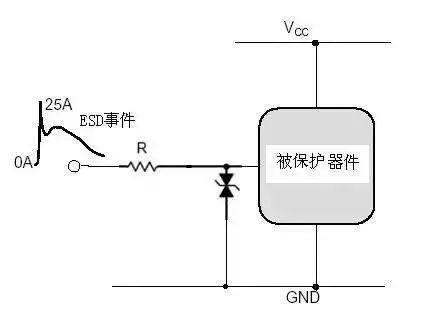
5、增加吸收回路
可以在敏感信号附件增加地的漏铜,来吸收静电。道理和避雷针原理一样。在信号线上放置尖端放电点(火花隙)在山寨手机设计中也经常应用。